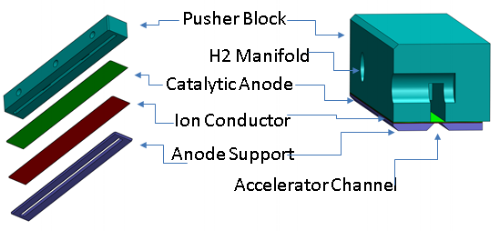Ion Injector
/The proton injector uses an anhydrous solid-state proton conductor as a cold ion source for the linear accelerator. The proton conductor is a perovskite that has a proton conduction of 1e-4 S/cm at 300 degrees kelvin. Hydrogen enters a manifold and passes through a platinum catalytic anode. Atomic hydrogen then passes through the ion conductor where a strong electric field on the accelerator side desorbs the proton. The activation energy to remove a proton from the surface is on the order of 0.22eV.
The ion injector assembly is ~30mm by 3mm. Ions are emitted through a slit in the anode support that is 26mm by 0.3mm (300um).
Ion Injector Entry Design
The active area of the ion selective membrane (ion conductor) is 2.62cm x 300um or 7.86e6 um2. Around 175 protons are required to expose a 20nm spot. Spots are written at a rate of 2e6 per second or about 3.50e8 ions/second (5.6e-11 amp) per accelerator channel. The proton current for a total array of 262,144 accelerator channels (one head) could be as much as 14.7ua. The H+ flow rate per head is 4.1e-4 sccm.
An Eizel lens assembly extracts the ions from the ion conductive membrane and focuses them with a 30x reduction to a 15um entrance slit. This slit has a 1.43 degree bevel that leads to the proton gates.


